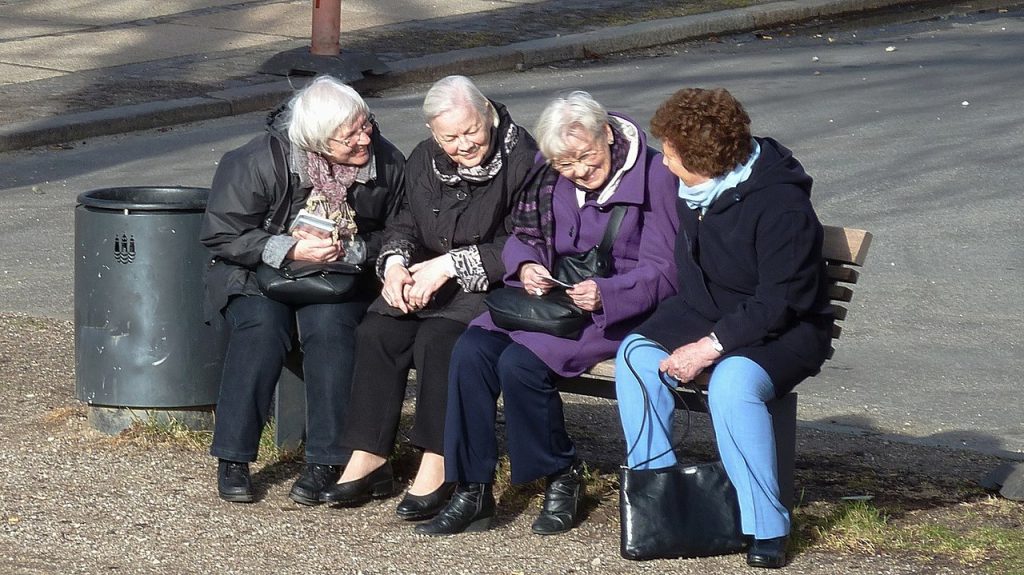163 Social Networks in Late Adulthood
Martha Lally; Suzanne Valentine-French; and Dinesh Ramoo
A person’s social network consists of the people with whom one is directly involved, such as family, friends, and acquaintances (Fischer, 1982). As individuals age, changes occur in these social networks, and the convoy model of social relations and socioemotional selectivity theory address these changes (Wrzus, Hanel, Wagner, and Neyer, 2013). Both theories indicate that less close relationships will decrease as one ages, while close relationships will persist. However, the two theories differ in explaining why this occurs.
The convoy model of social relations suggests that the social connections that people accumulate differ in levels of closeness and are held together by exchanges in social support (Antonucci, 2001; Kahn and Antonucci, 1980). According to the convoy model, relationships with a spouse and family members, people in the innermost circle of the convoy, should remain stable throughout the lifespan. In contrast, coworkers, neighbours, and acquaintances, people in the periphery of the convoy, should be less stable. These peripheral relationships may end due to changes in jobs, social roles, location, or other life events. These relationships are more vulnerable to changing situations than family relationships. Therefore, the frequency, type, and reciprocity of the social exchanges with peripheral relationships decrease with age.
The socioemotional selectivity theory focuses on changes in motivation for actively seeking social contact with others (Carstensen, 1993; Carstensen, Isaacowitz, and Charles, 1999). This theory proposes that with increasing age, our motivational goals change based on how much time one has left to live. Rather than focusing on acquiring information from many diverse social relationships, as noted with adolescents and young adults, older adults focus on the emotional aspects of relationships. To optimize the experience of positive affect, older adults actively restrict their social life to prioritize time spent with emotionally close significant others. In line with this theory, older marriages are found to be characterized by enhanced positive and reduced negative interactions and older partners show more affectionate behaviour during conflict discussions than do middle-aged partners (Carstensen, Gottman, and Levenson, 1995). Research showing that older adults have smaller networks compared to young adults, and tend to avoid negative interactions, also supports this theory.

Relationship with adult children: Many older adults provide financial assistance and/or housing to adult children. There is more support going from the older parent to the younger adult children than in the other direction (Fingerman and Birditt, 2011). In addition to providing for their own children, many elders are raising their grandchildren. Consistent with socioemotional selectivity theory, older adults seek and are helped by their adult children providing emotional support (Lang and Schütze, 2002). Lang and Schütze, as part of the Berlin Aging Study (BASE), surveyed adult children (mean age fifty-four) and their aging parents (mean age eighty-four). They found that the older parents of adult children who provided emotional support, such as showing tenderness toward their parent, cheering the parent up when they’re sad, tended to report greater life satisfaction. In contrast, older adults whose children provided informational support, such as providing advice to the parent, reported less life satisfaction. Lang and Schütze found that older adults wanted their relationship with their children to be more emotionally meaningful. Daughters and adult children who were younger, tended to provide such support more than sons and adult children who were older. Lang and Schütze also found that adult children who were more autonomous rather than emotionally dependent on their parents, had more emotionally meaningful relationships with their parents, from both the parents’ and adult children’s point of view.
Friendships: Friendships are not formed in order to enhance status or careers, and may be based purely on a sense of connection or the enjoyment of being together. Most elderly people have at least one close friend. These friends may provide emotional as well as physical support. Being able to talk with friends and rely on others is very important during this stage of life. Bookwala, Marshall, and Manning (2014) found that the availability of a friend played a significant role in protecting the health of an older person experiencing the impacts of widowhood. Specifically, those who became widowed and had a friend as a confidante reported significantly lower somatic depressive symptoms, better self-rated health, and fewer sick days in bed than those who reported not having a friend as a confidante. In contrast, having a family member as a confidante did not provide health protection for those recently widowed.
Loneliness or solitude?: Loneliness is the discrepancy between the social contact a person has and the contacts a person wants (Brehm, Miller, Perlman, and Campbell, 2002). It can result from social or emotional isolation. Women tend to experience loneliness due to social isolation; men from emotional isolation. Loneliness can be accompanied by a lack of self-worth, impatience, desperation, and depression. Being alone does not always result in loneliness. For some, it means solitude. Solitude involves gaining self-awareness, taking care of the self, being comfortable alone, and pursuing one’s interests (Brehm et al., 2002).
Media Attributions
- Figure 9 38 © Comrade King is licensed under a CC BY-SA (Attribution ShareAlike) license

